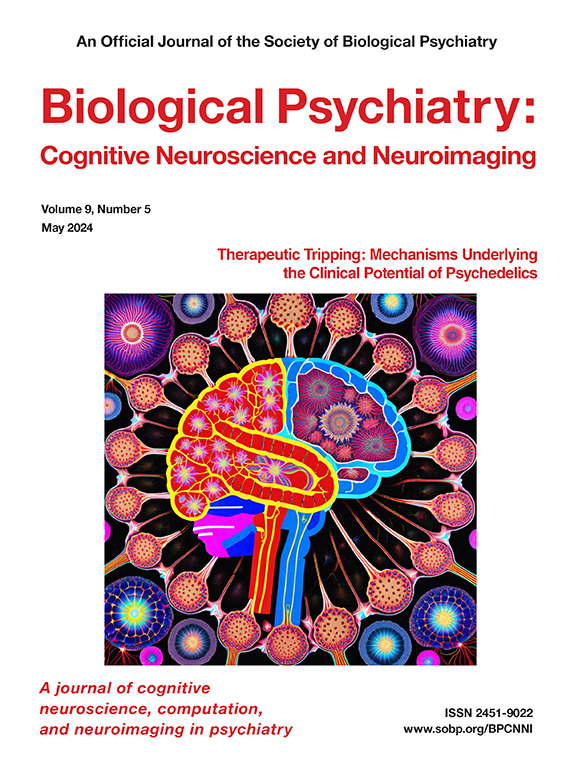在一项随机对照试验中,症状激发时杏仁核激活的增加可预测强迫症患者对重复经颅磁刺激和暴露疗法的反应。
IF 5.7
2区 医学
Q1 NEUROSCIENCES
Biological Psychiatry-Cognitive Neuroscience and Neuroimaging
Pub Date : 2025-03-01
DOI:10.1016/j.bpsc.2024.10.020
引用次数: 0
摘要
背景:重复经颅磁刺激(rTMS)与暴露和反应预防(ERP)相结合,是治疗难治性强迫症(OCD)的一种很有前景的治疗方式。然而,并非所有患者都对这种治疗方法有足够的反应。我们研究了在症状激惹任务中大脑激活是否能预测治疗反应:61名成人强迫症患者(22名男性/39名女性)在接受为期8周的经颅磁刺激和ERP联合治疗之前,在fMRI中接受了强迫症和恐惧相关视觉刺激的症状刺激。作为随机对照试验的一部分,参与者接受了以下三种经颅磁刺激治疗之一:(1)左侧背外侧前额叶皮层(DLPFC)10Hz经颅磁刺激(110%静息运动阈值(RMT));(2)左侧前补充运动区(preSMA)10Hz经颅磁刺激(110% RMT);或(3)顶点10Hz对照经颅磁刺激(60% RMT)。利用多元回归和相关性研究了任务相关脑激活对以下ROI的治疗反应的预测价值:背内侧前额叶皮层、杏仁核、DLPFC和preSMA:结果:不同治疗组对治疗的反应相同。在所有治疗组中,右侧杏仁核对强迫症相关刺激的较高治疗前任务相关激活与治疗反应呈正相关。探索性全脑分析显示,多个任务相关区域的激活与治疗反应呈正相关。只有背侧前扣带回皮层对恐惧相关刺激的激活与治疗结果呈负相关:结论:在症状激发时,治疗前较高的右杏仁核激活可预测强迫症患者对经颅磁刺激和ERP联合治疗的较好治疗反应。本文章由计算机程序翻译,如有差异,请以英文原文为准。
Increased Amygdala Activation During Symptom Provocation Predicts Response to Combined Repetitive Transcranial Magnetic Stimulation and Exposure Therapy in Obsessive-Compulsive Disorder in a Randomized Controlled Trial
Background
Repetitive transcranial magnetic stimulation (rTMS) combined with exposure and response prevention is a promising treatment modality for treatment-refractory obsessive-compulsive disorder (OCD). However, not all patients respond sufficiently to this treatment. We investigated whether brain activation during a symptom provocation task could predict treatment response.
Methods
Sixty-one adults with OCD (39 female/22 male) underwent symptom provocation with OCD- and fear-related visual stimuli during functional magnetic resonance imaging prior to an 8-week combined rTMS and exposure and response prevention treatment regimen. Participants received one of the following 3 rTMS treatments as part of a randomized controlled trial: 1) 10-Hz rTMS (110% resting motor threshold) to the left dorsolateral prefrontal cortex, 2) 10-Hz rTMS (110% resting motor threshold) to the left presupplementary motor area, or 3) 10-Hz control rTMS (60% resting motor threshold) to the vertex. Multiple regression and correlation were used to examine the predictive value of task-related brain activation for treatment response in the following regions of interest: the dorsomedial prefrontal cortex, amygdala, dorsolateral prefrontal cortex, and left presupplementary motor area.
Results
The different treatment groups responded equally to treatment. Higher pretreatment task-related activation of the right amygdala to OCD-related stimuli showed a positive association with treatment response in all groups. Exploratory whole-brain analyses showed positive associations between activation in multiple task-relevant regions and treatment response. Only dorsal anterior cingulate cortex activation to fear-related stimuli showed a negative association with treatment outcome.
Conclusions
Higher pretreatment right amygdala activation during symptom provocation predicts better treatment response to combined rTMS and exposure and response prevention in OCD.
求助全文
通过发布文献求助,成功后即可免费获取论文全文。
去求助
来源期刊

Biological Psychiatry-Cognitive Neuroscience and Neuroimaging
Neuroscience-Biological Psychiatry
CiteScore
10.40
自引率
1.70%
发文量
247
审稿时长
30 days
期刊介绍:
Biological Psychiatry: Cognitive Neuroscience and Neuroimaging is an official journal of the Society for Biological Psychiatry, whose purpose is to promote excellence in scientific research and education in fields that investigate the nature, causes, mechanisms, and treatments of disorders of thought, emotion, or behavior. In accord with this mission, this peer-reviewed, rapid-publication, international journal focuses on studies using the tools and constructs of cognitive neuroscience, including the full range of non-invasive neuroimaging and human extra- and intracranial physiological recording methodologies. It publishes both basic and clinical studies, including those that incorporate genetic data, pharmacological challenges, and computational modeling approaches. The journal publishes novel results of original research which represent an important new lead or significant impact on the field. Reviews and commentaries that focus on topics of current research and interest are also encouraged.
 求助内容:
求助内容: 应助结果提醒方式:
应助结果提醒方式:


